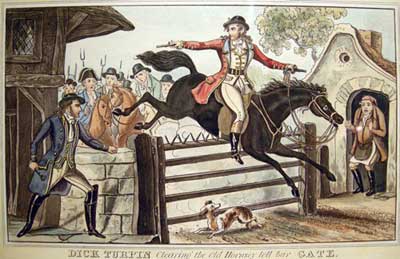 |
A SCARCE VIEW OF THE NOTORIOUS HIGHWAYMAN

DICK TURPIN
Clearing the old Hornsey Toll Bar Gate, to the surprise of his pursuers.
Hand coloured etching, matted glazed, heavy gilt-wood and stain frame.
Image: 7 1/4 x 11 1/8" including letters. Frame: 15 1/2 x 19 1/2"
Ref. NC2/DAL/gannr>AVL SOLD PRICE CODE B Click here for price guide
Published by J.I. Marks London 1836. This hand coloured etching vividly portrays the audacious Richard 'Dick' Turpin, aka. John Palmer, then the most notorious Highwayman in England. Seated on his horse Black Bess he jumped the Hornsey Toll Gate (near London) which was said to be twelve foot high with a Chevaux de fries (outward facing spikes) along the top rail. The image obviously diminishes the gate size for artistic merit. But even so, those in hot pursuit look surprised at his feat.
In the early 1730s, Turpin had joined a gang of deer thieves and, later, became a poacher, burglar, horse thief and killer. He is also known for a fictional 200-mile (320 km) overnight ride from London to York on his horse Black Bess, a story that was made famous by the novelist William Ainsworth almost 100 years after Turpin's death. The novel and other ‘penny-dreadful’ tales did much to turn Turpin’s criminal exploits into that of a folk hero. In 1735 he moved to Yorkshire and assumed the alias of John Palmer. While he was staying at an inn, local magistrates became suspicious of "Palmer" and made enquiries as to how he funded his lifestyle. Suspected of being a horse thief, "Palmer" was imprisoned in York. Turpin's true identity was revealed by a letter he wrote to his brother-in-law from his prison cell, which fell into the hands of the authorities. On 22 March 1739, Turpin was found guilty on two charges of horse theft and sentenced to death; he was executed on 7th. April 1739.
|
 |
 |



